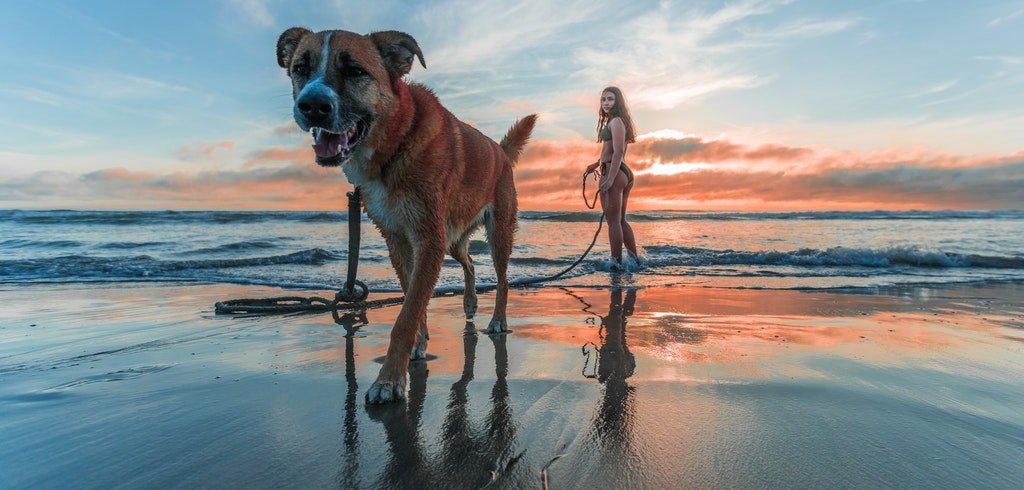Using a longline may be the best way to start your puppy’s stay, recall, and distance training. You can also use it to retrain an older dog or rescue dog, or to have fun in areas where you can’t let your dog off-leash due to leash laws.
What Is A Longline?
A longline, sometimes called a houseline, is an extra-long leash that gives your dog a lot more freedom. They come in lengths from 15 to 50 feet and in various forms of nylon, cotton, or acrylic, but can be as simple as a long piece of rope and a hook. Whatever you choose, ensure the leash is strong enough for the size of your dog and safe for you to handle.
What Is A Longline Used For?
- Recall training for puppies
- Retraining an older dog or a rescue dog
- As a back-up for a young or nervous dog at the park
- Exercising your dog in an open space, while still maintaining control
- Specialized training, such as agility or tracking
- Giving your dog some freedom in areas they can’t be off-leash
- Testing out what your dog will do and how they will behave off-leash
- Teaching life saving training games
What Is A Reliable Recall?
According to the American Kennel Club, a “reliable recall“ means when you call your dog to come, you want to be 99.99% sure they are going to enthusiastically respond. Having a reliable recall is especially important if you want to allow your dog to run off-leash outside of a fenced yard or at a dog park. Even if your dog doesn’t go off-leash, reliable recall is an important skill for any dog in the event of an emergency.
Come When Called is one of ten skills required for your dog to become a certified Canine Good Citizen, a training program that’s open to all dogs–purebred and mixed breed–that focuses on teaching the basics of good manners and obedience, instilling the values of responsible ownership, and strengthening the bond between you and your dog at home and out in the community.
Training With Your Longline
If you’re training your dog to come when called, start in a low-distraction environment. Make sure you have treats, a toy, or both for rewards. One of the most important parts of recall training is to make it a game for your dog. Let the dog scope out the new leash before you clip it to their collar. Give them a few seconds to sniff and maybe even lick the leash, but don’t let them chew it.
Do not use the leash for physical correction or reeling the dog in. Physical leash corrections will make them overly aware of and dependent on the leash. This will result in the dog only responding when they are on-leash and ignoring commands when the leash is off.
Begin working your dog with approximately five feet of leash, keeping a firm hold on the rest. Never coil it around your hand, as this could result in severe injury to your hand or arm. Let your dog explore their new freedom, but keep their attention on you. Try commands they may already know well, such as sit or stay.
Try walking away from your dog. If you’ve already trained for stay, make them stay while you put three to five feet between the two of you. When you’re ready, call them to you. If they won’t come, try getting excited or showing them their treats or toy. Keep rewarding successful recalls with praise and affection, as well as treats or play time with the toy. Treat-based training has the strongest reinforcement for training in animals, but seeing that you are pleased with them will have a massive impact on how much they will engage with your training. After a few repetitions, whenever your dog looks at you and starts to move towards you, add in your chosen verbal cue (come, here, etc.) Make sure to only add in the cue when you are confident your dog is moving towards you.
Once you’re comfortable, as your dog becomes compliant and reliable with focus and commands, increase the length of the leash. If you can successfully recall them from that distance, increase it again, giving them more and more of the leash to use. Instead of focusing on taking away your dog’s freedom, the goal is to have your dog earn freedom through compliance and trust. When you’re ready, try recalling them without the leash.
Recall Training Tips
It’s essential to train for the same commands, in the same way, consistently. Do not repeat yourself and poison the cue. If you have to repeat your cue, the environment may be too distracting or your dog does not understand the skill well enough for the level you are trying to train. Do not punish your dog for failed recalls or if they take their time before coming to you. Always praise a recall. Dogs learn by trying to do what it takes to get a reward, not by avoiding punishment. Daily training is a must, with shorter sessions two or three times daily being the most beneficial. Slowly increase difficulty and level of distraction.
Final Thoughts
With patience and consistency, your dog will have a reliable recall. Keep the longline handy for retraining, freedom in areas your dog can’t be off-leash, if you aren’t confident in their recall, or if you plan on specialized training.
There is no shame in keeping your dog on-leash if you are not confident in their recall. Some dogs will never have a recall that is safe or reliable in all situations, but they can still have fun with a longline!
